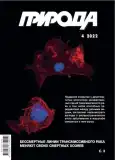Rivers in the North of Yakutia: what Determines the Destruction of the Frozen Banks
- Autores: Murzin Y.A1
-
Afiliações:
- Melnikov Permafrost Institute, Siberian Branch of RAS
- Edição: Nº 4 (2022)
- Páginas: 38-45
- Seção: Articles
- URL: https://journals.eco-vector.com/0032-874X/article/view/627738
- DOI: https://doi.org/10.7868/S0032874X22040044
- ID: 627738
Citar
Texto integral
Resumo
Northern Yakutia is characterized by continuous permafrost with a thickness of 300–400 m or more with temperatures from –6 to –10°C. The occurrence of permafrost affects the rates of thermal erosion and thermal abrasion of river banks. Many investigators believe that permafrost inhibits fluvial erosion, while others think it has an enhancing effect. Our investigations along the lower reaches of the Indigirka, Adycha, and Kolyma rivers have shown that the effect of permafrost varies depending on site specific conditions. The highest rate of thermal erosion (60 m/year) was observed in the Lower Indigirka region. This was promoted by the high ice content of the yedoma deposits, the presence of a talik beneath the channel, as well as the great water depths and strong currents. Bank recession along the meandering Adycha River, the Yana River tributary, occurs at rates of less than 1 m/year. The low rates of bank erosion can be explained by the low thickness of loose deposits (up to 3–5 m), which lay on the channel pebbles and generally remains above the low- and medium-water levels. Also, the coastal cliff deposits consisting of silty sand with a massive cryostructure and thin ice veins turned to be relatively resistant to erosion.
Palavras-chave
Sobre autores
Yu. Murzin
Melnikov Permafrost Institute, Siberian Branch of RAS
Email: murzin@mpi.ysn.ru
Yakutsk, Russia
Bibliografia
- Самойлов И.В. Устья рек. М., 1952.
- Григорьев Н.Ф. Роль криогенных факторов в формировании морских берегов Якутии. Многолетнемерзлые породы и сопутствующие им явления на территории Якутской АССР. М., 1962; 68–78.
- Любимов Б.Н. Опыт составления карты размываемости горных пород на территории европейской части СССР. Закономерности проявления эрозионных и русловых процессов в различных природных условиях: Тезисы докладов Первой всесоюзной межвузовской конференции. М., 1972; 52–54.
- Богомолов А.Л., Заец Г.М., Коротаев В.Н. и др. Основные процессы, формирующие дельту р.Индигирки. Эрозия почв и русловые процессы. М., 1979; 7: 146–159.
- Маккавеев Н.И. Русло реки и эрозия в ее бассейне. М., 1955.
- Ершов Э.Д., Малиновский Д.В., Кучуков Э.З. и др. Термоэрозия дисперсных пород. М., 1982.
- Литвинов А.Я. Осадка при протаивании льдистых суглинков Яно-Индигирской приморской низменности. Материалы к основам учения о мерзлых зонах земной коры. М., 1960; 5: 56–72.
- Толстов А.Н. Некоторые данные о разрушении берегов в нижнем течении р.Индигирки. Вопросы географии Якутии. Якутск, 1962; 2: 123–127.
- Шур Ю.Л., Петрухин Н.П., Славин-Боровский В.Б. Разрушение берегов в криолитозоне. Криогенные процессы. М., 1978, С. 57–73.
- Мурзин Ю.А. Флювиальная переработка ледового комплекса в низовьях р.Индигирки. Климат, почвы, мерзлота. Комплексные исследования в районах Сибири и Дальнего Востока. Новосибирск, 1991; 157–162.
- Мурзин Ю.А. Флювиальная переработка берегов рек Северной Якутии. Динамика и термика рек, водохранилищ и прибрежной зоны морей: Труды VIII Международной научно-практической конференции. М., 2014; 2: 108–113.
Arquivos suplementares











